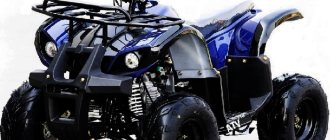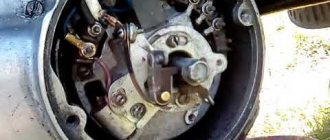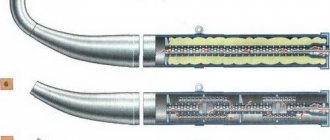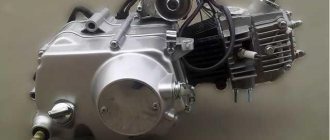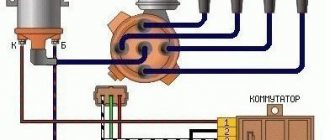Structure and principle of operation
The cold start system works like a second mini-carburetor, in which the solenoid valve acts as a throttle. It is open only at start and gradually closes when the engine warms up.
The air mixture enrichment system consists of:
— emulsion tube of the enricher,
- jet in the float chamber cover,
Eliminating the causes
It will be cheaper to supply a high-quality Chinese piston with rings, since Chinese rings will not fit on a Japanese piston.
And if the output is large, then you need to bore a Japanese cylinder for a repair piston, rather than buy a complete Chinese piston kit.
— unscrew the solenoid valve and make sure that it is not externally collapsed and that the needle does not fall out of it. If the needle falls out of the solenoid valve body, replace the valve with a new one.
The solenoid valve must have a intact rubber o-ring. If the ring is cut, be sure to replace it with a new one to prevent air leaks.
— unscrew the float chamber cover; clean and bleed the fuel nozzle of the enricher,
— check whether the emulsion tube of the enrichment device is tightly seated; if the tube is easily pulled out, then solder the seat around with tin and put the tube in place,
- blow out and clean all cold start channels with soft copper wire,
— check the functionality of the solenoid valve. Take the dropper tube or hose from the car washer system. Place it close to the cold start channel, blow into the tube with your mouth - air should pass through the channel unhindered.
— connect 12 volt power to the solenoid valve and check the cold start hole again for ventilation. In this case, the air should be blown through with difficulty, which means the solenoid valve is in order.
- install the carburetor in its place,
- screw on the air filter,
- check the engine start - push it 10 times until the float chamber and enrichment chamber are filled with gasoline. The scooter should start. The revolutions will first rise slightly, and after a few minutes they will drop,
- After that, adjust the idle speed.
Subscribe to updates. I hope that the article will be useful to you in finding and eliminating the cause of poor starting of the scooter.
Source
What to do
If the chainsaw engine does not start and there are traces of fuel and oil on the spark plug electrodes, it is necessary to establish the cause of their appearance. This will determine what needs to be done to eliminate it. If fuel injection occurs when starting the unit, then it is necessary to remove the fuel mixture accumulated in the engine crankcase. To do this, turn the spark plug out, turn the chainsaw upside down and turn the crankshaft with a manual starter. Such manipulations need to be done at least 25-30 times.
After this, the removed part is put back in place and the engine is started in accordance with the operating instructions. If interruptions occur during the operation of the unit, this indicates a defective spark plug. Over time, the electrodes of the spark-forming device burn, resulting in an increase in the gap between them. This results in a weak spark that cannot ignite the fuel.
Unburnt fuel settles on the electrodes and sparking stops.
The gap is adjusted using a feeler gauge. For two-stroke engines, the distance between the electrodes should be 0.7-0.9 mm. Splashing of contacts can occur due to an overly rich mixture. This can be caused by poor carburetor adjustment or a clogged air filter.
Causes of malfunctions of the two-stroke engine of a chainsaw or lawn mower.
1. Violation of the tight fit of gaskets and individual parts of the unit.
Contamination of the carburetor and the formation of additional carbon deposits on the piston head and spark plug. The more dirt gets into the working chamber of the cylinder, the more noticeable the smoke will be in the exhaust gases. The smoke is light gray to black with a corresponding burning smell. The exhaust hole of the muffler and cylinder become covered with oily or dry carbon deposits, which narrows the holes. The piston and the bottom of the cylinder are covered with carbon deposits, which, depending on the nature of the contamination, can be solid or have the appropriate viscosity. Stopping the engine is possible due to a short circuit of the spark plug electrode to ground or due to jamming of the piston. In the best case, the compression rings will stick or engine detonation will occur after the ignition is turned off.
Air leaks, lean mixture or lack of it. The engine will have difficulty starting with the choke closed, but will not run normally. There is no idle speed. The carburetor is covered with damp dust and in some cases you can see air bubbles or fuel leakage at the joints of the carburetor parts.
With the carburetor choke closed, a cold engine can start and run at higher speeds. The idle speed is broken or completely absent. When the cylinder heats up, the gap between the cylinder and the carburetor will increase and the engine will stall. Before this, it will begin to lose power in the optimal mode, not to mention the maximum power mode.
During one of the periods of engine operation, the piston moves down the cylinder. Passing by the intake window, with its skirt it cuts off part of the volume with the fuel-air mixture formed in the diffuser, and passes the mixture into the upper part of the cylinder through the bypass channels / photo 1 /.
If the seal between the cylinder and the crankcase is poor, the piston will not create sufficient pressure necessary for the operation of the fuel pump and will not be able to move the fuel-air mixture to the upper volume of the cylinder.
Compression may be good or even very good, but there is little or no pressure to operate the fuel pump. The engine will not start or will start with great difficulty, but not for long. There is a noticeable increase in fuel consumption.
When the gasket is torn, a microcrack appears in the crankcase, or the cylinder pinch bolts are slightly pressed out, the pressure created by the piston to operate the carburetor fuel pump will be insufficient or completely absent. And no matter what you do, the engine will not start. Even when, after injecting fuel into the carburetor diffuser or directly into the cylinder through the spark plug hole, the engine “shudders,” it will work as long as the injected fuel lasts. And this is a second or a little more.
The crankcase cavity communicates with the carburetor fuel pump membrane through through hole
1 in the engine cylinder / photo 3 /. A slot is made on the crankcase wall at the place where the cylinder attaches (photo 2), which coincides with hole A on the base of the cylinder / photo 3/.
When a 'caring' owner installs a new gasket somehow, when the hole becomes clogged with dirt or blocked by the gasket, the engine will not even show a 'sign of life'. This will be a great mystery to many. A trifle, but what an addiction!
You can check by injecting fuel into the carburetor diffuser or into the cylinder cavity through the spark plug hole. The engine will start immediately and then stall immediately. If two people are involved in the diagnosis, then it is enough for one to start the engine, and the second to inject fuel into the open carburetor diffuser with a medical syringe. The engine will start and run on injection in different carburetor modes.
The engine is difficult to start, idling is unstable, failures in operation during transient conditions are observed, fuel consumption is increased. There are signs that the seal between the cylinder and the crankcase is broken. There are noticeable leaks under the starter flywheel.
During inaccurate assembly, when the tightening bolts are loosened, or due to thermal deformation, the tightness between the cylinder and the engine muffler is broken. The noise level increases while the engine is running. The engine roars. Oily smudges are noticeable at the junction. Fuel consumption increases slightly.
The recommended gasoline for the corresponding engine must be mixed with oil that well lubricates the working surface of the cylinder, the piston with compression rings, the crankshaft, the connecting rod with bearings and the piston pin. At the same time, the oil should not coke during combustion. Excessive carbon deposits will lead to rapid wear of the engine, and what’s worse, to jamming.
Carbon deposits also form under the rings. When the engine is new, an excessive amount of oil in gasoline forms carbon deposits, which pushes the rings outward, increasing wear on the mirror surface of the cylinder, that is, “writing the group.” Longitudinal scratches from piston rings squeezed out by carbon deposits are visible on the cylinder wall.
Carbon deposits can also block the muffler inlet. In this case, the sound of the engine running is dull. At low speeds it works without load. From the exhaust pipe, the exhaust gases move with weak pressure and contain a lot of smoke. When the speed increases, the engine stalls. There are noticeable emissions of gases out through the carburetor when the air filter is removed.
Since the piston cannot squeeze out all the exhaust gases from the cylinder, it also cannot draw the required amount of the required fuel-air mixture into the cylinder. The more the muffler hole is blocked, the more difficult it is for the engine to start, or even not at all.
When the spark plug is not screwed in, a channel is formed in its threaded connection with the cylinder head, allowing the fuel-air mixture to flow out while the piston creates compression. And when the fuel in the cylinder is ignited, the amount of mixture squeezed out increases. Wet and oily streaks are visible around the spark plug head and on the cylinder head itself.
There may also be a defect in the spark plug , whose entire body is an insulator with a central electrode that rotates inside the nut. Compression with such a spark plug drops slightly. On the spark plug body, around the base of the insulator, a slight carbon deposit is visible from the leakage of gases during the explosion of the fuel-air mixture in the cylinder. View in new window.
In order to somehow improve a worn-out engine, you can increase the amount of oil mixed with gasoline. But it won't last long.
Why does a chainsaw fill a candle?
There are several reasons for this situation. In most cases, they are associated with incorrect operation of the fuel system, less often - with a defect in the spark plug itself or malfunctions of the ignition system. Products go on sale with factory settings of elements. Therefore, it is not worthwhile to immediately adjust the carburetor and ignition system. Most likely the user did not read the instructions or did not comply with its requirements.
The manufacturer recommends closing the air damper when starting the chainsaw. But this does not mean that the engine will work in this condition. The recoil starter must stop rotating when the first exhaust emission occurs. After this, the valve must be opened. If you do not do this and continue to crank the starter, the spark plug will flood, and the unburned mixture will collect in the crankcase.
The spark plug on a chainsaw can be filled even after several years of proper operation. In this case, the reason lies in the failure of the control membrane of the fuel chamber. Poor-quality material of the part loses its elasticity during prolonged contact with gasoline and the needle responsible for supplying fuel remains in the open position.
During operation of the tool, vibrations occur, which lead to changes in adjustments. Because of this, a highly enriched mixture is obtained, which does not completely burn and partially settles on the electrodes of the spark plug. This leads to malfunctions of the engine, and then to its stop.
SCOOTER WILL NOT START WHAT TO DO LET'S FIND THE REASONS
We are talking about a two-stroke engine; it happens that the engine does not start.
So why does this happen, there are a lot of reasons why a two-stroke engine won’t start.
First of all, you need to check the ignition system and the injection system; perhaps you do not have a spark, or the spark plug is flooded due to a large amount of fuel, or there is not enough at all.
First you need to check if there is a spark, which means unscrew the spark plug, connect a high voltage wire to the spark plug, place the spark plug on the cylinder head, and turn the crankshaft.
The spark plug must be clearly constant; the engine will not start if there is no spark or if it is present but it is not constant.
If there is still a spark, but the engine does not start, then you should pay attention to the fuel injection system; it may be that there is not enough fuel or, on the contrary, there is more than necessary.
Then you need to look at things like
Gas tank, tap, starting enrichment, and the carburetor itself.
The starting enrichment is checked by connecting it to the battery; its rod should extend.
The usual case is when the fuel valve fails; they are mainly installed with vacuum ones. To check it, you can disconnect the hose from the carburetor and create a vacuum in it; if gasoline does not flow, then change the valve.
Usually problems arise from the carburetor itself, then you just need to remove it and wash it and blow out all the channels and jets.
It may stop starting if there is no compression in the cylinder.
By the way, it happens that there is air leakage through the crankshaft oil seal, so this is also worth paying attention to.
If you missed something, write in the comments.
Reasons why a spark plug on a chainsaw floods and how to eliminate them
It often happens that trying to start a new chainsaw does not lead to the desired result. In most cases, this is due to the fact that the fuel mixture does not ignite, but floods the spark plug on the chainsaw. This situation is not a product defect and can be corrected on your own. The chain saw is equipped with a two-stroke gasoline engine, the stable operation of which depends on the correctly prepared mixture of fuel and engine oil. In the carburetor, the emulsion is enriched with air and enters the cylinder, where it must burn.
About miscellaneous...
Rules of communication in the forum
| Before you ask a question! How to correctly ask questions in the forum and use site materials. |
| Moscow time 02:44:26 | Your local time | Vladivostok time 09:44:26 |
| Reply to this message |
| Reply to this message |
| Reply to this message |
| Reply to this message |
| Reply to this message |
| Reply to this message |
| Reply to this message |
| Reply to this message |
| Reply to this message |
| Reply to this message |
| Reply to this message |
| Reply to this message |
| Reply to this message |
| Reply to this message |
| Reply to this message |
| Reply to this message |
| Reply to this message |
| Reply to this message |
| Reply to this message |
| Reply to this message |
| Reply to this message |
| Reply to this message |
| Reply to this message |
| Reply to this message |
| Reply to this message |
| Reply to this message |
| Reply to this message |
| Reply to this message |
| Reply to this message |
| Reply to this message |
| Reply to this message |
| Reply to this message |
| Reply to this message |
| Reply to this message |
| Reply to this message |
| Reply to this message |
Structure and principle of operation
The cold start system works like a second mini-carburetor, in which the solenoid valve acts as a throttle. It is open only at start and gradually closes when the engine warms up.
The air mixture enrichment system consists of:
— emulsion tube of the enricher,
- jet in the float chamber cover,
How to start a flooded two-stroke engine
It works on mowers, chainsaws and some outboard motors. It's scary because there comes a moment when it won't start and that's it.
Pull as much as you like - it's useless. I've had several situations like this. A way out of each of them was found, but the last situation (flooded engine) took 6 hours and a lot of Internet browsing. I'll leave this instruction here in summary.
How to properly start such a motor (scythe, saw)
It is important not to forget anything and follow the order of actions. Maybe then you won’t have to suffer at all.
1. Turn on the “on” toggle switch.
If you pull it out while the toggle switch is off, it will start to get rough.
On lawn mowers, also check to see if the gas is “locked up” and release it.
2. Press the fuel supply “frog” 10 times.
3. Pull out the choke
(look for a leak, it must be there and don’t ignore it). In this case, the choke should close the air damper so that the mixture is rich. In some devices it does not extend but switches, we need to figure this out.
4. Now we pull.
And we listen carefully.
The engine should almost start and STALL (normally).
No gasoline should escape from the muffler.
5. If step 4 is successful, we turn off the choke (open the plug) and pull. After a maximum of 3 tries, the engine should start and run at idle.
If the engine is hot, start it immediately with the choke on, but don’t forget
1. Turn on the toggle switch 2. If we have run out of fuel before, pump the frog.
What to do if there is a complete bummer
You tug on the suction pump but nothing happens. There are basically 2 reasons.
1. The spark plug does not produce a spark.
2. Congratulations, you have flooded the engine (spark plug) by endlessly pumping and jerking (for example, with the toggle switch off)
How to check ignition (plug-spark)
1. Remove the casing from the spark plug
2. Unscrew the spark plug with a special key (usually attached to a scythe or saw)
3. Put on the casing (do not screw in the spark plug)
4. Carefully connect (with a screwdriver) or something with insulation, so that you are not shocked by the current, the spark plug housing with the motor housing. The answer is best because it has an insulated handle.
If it doesn’t spark, you don’t have to do anything else. You need to change the spark plug and if it doesn’t spark, change the ignition coil, that is, this is a repair.
How to overcome a flooded engine
So, let's say there is a spark, but nothing starts.
1. Unscrew the candle and look at it. If it is damp (wet), wipe it and set it aside to dry.
2. Remove the air filter (most likely it will be wet), wring it out, and put it to dry.
3. Turn the device over with the hole from the spark plug facing in and turn the starter. In the process, gasoline should fly out of the hole. We pull until it stops flying out.
4. In general, after this procedure you can try to start it. (Screw in the spark plug, put on the cover, turn on the toggle switch, pump fuel, remove the choke and pull). It is NOT a FACT that this will happen, because there is also gasoline in the muffler.
4. I looked up how to get gasoline out of the muffler on YouTube and learned it myself - it worked.
5. The carburetor must be completely removed. It's filmed like this. We remove the air filter, see the damper - there are usually 2 screws on each side of the damper, you need to unscrew them and the carburetor will fall out on you - this kind of crap the size of a fist that stands between the air, the gas tank and the engine and mixes the air with gasoline. So, it must be stupidly removed completely (carefully removing the fuel hoses). You will be left with a bare hole in the engine.
6. Screw in the dry spark plug and put on the casing. Turn on the toggle switch. We turn the starter - the engine should start without a carburetor and burn gasoline in the muffler. We try several times - when it stops starting and squealing, we calm down - all the gasoline has been burned.
7. Put the carburetor back (assuming it is working). And now we are trying to start a fairly dry engine. I still got it started.
If nothing happens, the carburetor is most likely to blame. They also disassemble it - there is a membrane there (should not be torn), there is a rocker arm and a needle (should move when pressed). Here I highly recommend this video. https://m.youtube.com/watch?v=z_mGGcEcQTQ
The Video shows how to remove the carburetor, what to check in it, how to start it without a carburetor. I didn’t remove the needle - I just looked that the rocker was moving, the membrane was alive, I made some play according to the recommendation of this worthy uncle (although nothing was stuck) and calmed down. It was much more useful to clean the muffler of gasoline.
After that, everything started up for me and the next day, if the correct order was followed, everything started up again and worked.
P.S. Typical mistakes.
1. Wrong mixture of beznin - oil. I use the instructions for the oil. If you mixed it incorrectly, drain everything and do it again.
2. They forgot to turn on the toggle switch and turned the starter with the ignition off. Most likely the engine was flooded.
3. You ran out of gas on the “locked” gas and you never turned it off. You have added gasoline and are pulling the starter with full throttle (it may start, but most likely it will flood)
4. Sometimes, in periods of complete despair, I was able to start a flooded engine by pressing the gas. But this is despair and it means you have already done something wrong.
5. Before taking it in for repairs, do everything described here - most likely something will work. Because it’s a shame when they play a little trick at the repair shop and just start it without repairing it.
Post Post Scriptum
You can read what you definitely shouldn’t do in our article “Bad Advice.”
Sincerely yours, “Sea of Boats” team
Your message has been sent
Problems with motor pumps and pumps. Repair of pumping equipment
Motor pumps and pumps, like any equipment, can become faulty or simply malfunction. You can disassemble them yourself for minor repairs or routine inspection. It is, of course, better to have the engine work done by a mechanic. If there is a warranty period for the units (if they break down), you must contact the service center.
Below you will find out in which cases you can fix a motor pump or pump malfunction at home, and when you should call repairmen.
Motor pump problems and their elimination
The engine does not start.
A breakdown that can be caused by various reasons. For elimination:
- First of all, we check whether there is fuel in the pump tank. Sometimes it is enough to add gasoline.
- When the oil sensor indicates a low level, the engine must be filled with the correct fluid to the required level to operate.
- Check that the equipment is turned on correctly. The motor pump can only be started in a horizontal position.
- A closed fuel valve can also cause the engine to become silent. To make it work, open the tap and unscrew the drain plug located in the lower part of the carburetor chamber. Wash the filter with gasoline, “blow” it with air to clean it and put it back in place.
- Check whether the carburetor choke is closed and clean.
- It is possible that oil is getting into the combustion chamber of the motor pump. To avoid this, remove the spark plug and turn the engine crankshaft while pulling the starter cord several times.
- Make sure the air filter and spark plugs are clean. If the latter has carbon deposits, feel free to clean it off. Be sure to screw the candle tightly when inserting it into place.
- The cause of the problem may be a dirty air filter. It needs to be cleaned or replaced.
- The speed controller may be faulty. In this case, only specialists can help.
Unstable operation of the motor pump.
Problems with the pump part of the motor pump (no suction).
Most problems of this type are caused by either damaged parts or improper operation. In order to fix:
- Check the intake hose - it may be sucking in air due to damage.
- The pump seal may also draw in air. If this is the problem, the part must be replaced.
- There must be sufficient water level in the pump section.
- The drain plug must be tightened securely.
Low performance of the motor pump.
If the equipment initially worked at 5 stars, but recently it is barely pumping water, try the following instructions:
- Clean the intake filter and check that the water level is sufficient.
- Incorrect connection to the intake hose and mismatch in diameter. In this case, correct installation is required.
- If there is water in the outlet hose or, conversely, it is blocked, the motor pump cannot operate at full capacity. By opening the valves and releasing the liquid from the hose, productivity can be increased.
Equipment overheating.
- The ambient temperature for normal operation of the motor pump should not exceed +40°C.
- If the motor pump is operated at an altitude of more than 2 km above sea level, the unit must be adjusted before operation.
Pump problems and their elimination
Designed to withstand harsh conditions, our deep-well and submersible water pumps are ruggedly constructed and offer reliable, long-lasting performance. Their failure during proper use is a fairly rare occurrence. If this happens, repairs must be made to prevent more serious problems in the water supply.
Possible problems include:
Wear defects.
The pump is almost constantly located near water, the impact of which can lead to malfunction. This process occurs gradually, so regular preventive inspection of the device is necessary. In this case, it is not at all necessary to replace the deep-well pump; sometimes it is enough to make the repair yourself by replacing worn parts. Submersible pumps that have minor breakdowns are easier to repair than deep pumps.
The time relay and protection system do not work.
The reason is clogging of the internal pump system with small foreign particles from the soil. If suddenly the pump was operating in “dry mode,” then the internal mechanisms may be damaged due to the rapid use of oil during such operation. For repair you need:
- Clean the “insides” of the equipment from debris;
- Check the oil level;
- Check for damaged structures. If there is, replace it.
Noises are heard during operation.
Typically, noise occurs due to a mechanical breakdown, which can be corrected independently if you have instructions for the equipment. Before this, you need to check the electrical system, which includes the engine and automation system.
Disabling the device.
Not everyone will be able to identify a breakdown at first glance. Even if it is visible, all equipment must be checked.
- First you need to make sure that there was no elementary overload, which caused the machine and the system to turn off. Having disassembled the junction box, you can see the burnt out part.
- If there are no signs of combustion, you need to check the rotation of the engine in a free state. Remove the impeller from the shaft and turn it. Most modern motors are single-phase, so a “smoothing capacitor” is connected to them in a special winding for a smoother start of the pump. By turning the shaft of such an engine, you can understand whether it has burned out or not.
- If the shaft does not rotate, it means that a mechanical failure has occurred or it is jammed by soil particles (for example, in the absence of a protective filter).
- Further disassembly of the equipment may only be possible for those who deal with electronics. It is not recommended for ignorant people to disassemble the electric motor. The most reasonable thing is to contact a workshop to repair the electric motor.

